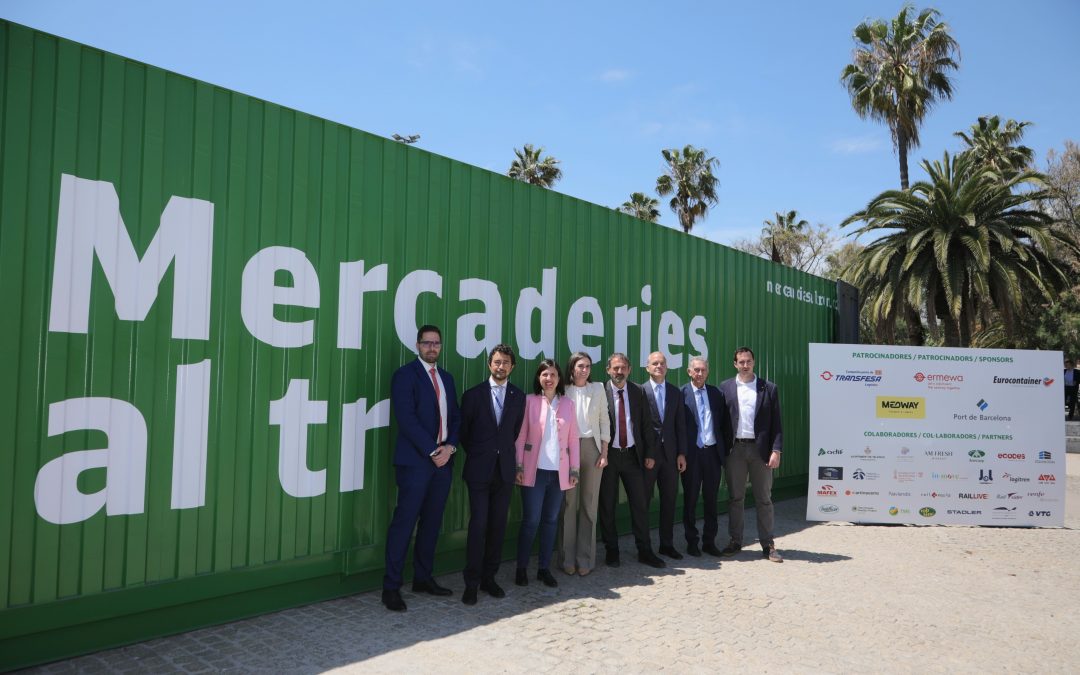The Port of Barcelona is the venue for a campaign that aims to bring the role of the freight railway in the future of sustainable transport closer to the public.
Institutions, companies and non-profit organisations have come together to support this European initiative that seeks to raise awareness of the need to create a supply chain free of CO2 emissions, where the train is the central axis.
Francisco Javier Flores García, general secretary of Infrastructures of the Ministry of Transport, Mobility and Urban Agenda of the Spanish Government was present at the presentation of the campaign to show the Ministry’s support for this type of transport.
The event in the city of Barcelona is sponsored by Transfesa Logistics, Port de Barcelona, Eurocontainer, Ermewa and Medway.
This morning, the Port of Barcelona hosted the official inauguration of the ” Freight belongs on rail” campaign in the city, an itinerant European initiative which, after passing through Valencia, Alicante and being present at the Rail Live! congress-fair, arrives in Barcelona on 6, 7 and 8 May.
The CEO of Transfesa Logistics, Idoia Galindo, pointed out that “it is a memorable day, since, for the first time, railway companies, public institutions, clients and institutions that fight against climate change are united for the same purpose: to boost freight railway”. In this sense, she explained that “It is a European movement that has already passed through Valencia, Alicante and that today we are inaugurating here in Barcelona, an strategic place for freight, since it is the Community with the highest railway quota, an example of commitment to this type of transport”.
In the words of Idoia Galindo, “We are taking this container out of the terminals to highlight the railway as a crucial element in the reduction of CO2 emissions in the transport sector, which today account for almost 30% of the total in Europe”.
She recalled that transporting goods by rail reduces CO2 emissions by up to 80%. It reduces external costs by up to 50%, which means fewer deaths on the roads. It consumes 6 times less energy, is 9 times better in terms of CO2 emissions and 8 times better in terms of air pollution.
She also took the opportunity to insist that forecasts say that by 2030 there will be 30% more goods transported. Galindo recalled that “If we do nothing, these goods will also go by road, so there will be 30% more CO2 emissions into the atmosphere”. In order to achieve emission-free supply chains, she explained that the combination of train and lorry, i.e. intermodal transport, is absolutely key. With the electric lorry, “door-to-door” transport could be carried out, and with the railway, long journeys from terminal to railway terminal.
For his part, Damià Calvet i Valera, president of the Port of Barcelona stressed in his speech that “it should not be heroic to put more goods on the train. It has been for too many years and the rail quota proves it. It is not the desired quota, despite the fact that at the Port of Barcelona we have been giving prominence to the train for decades and we now move more than 15% of containers by rail”. He added that “we are firmly committed to the growth of the rail quota and to the initiative promoted by Transfesa Logistics to decarbonise logistics activity”.
Next, Francisco Javier Flores García, general secretary of Infrastructures of the Ministry of Transport, Mobility and Urban Agenda of the Spanish Government recalled that “the Government has made available 900 million euros in direct aid to companies that believe in the railway and are taking risks to make this transformation possible”.
An exhibition open to the public
During the three days in which the freight container will be on display, it will not only be possible to see a freight container on the street, out of its usual location, but it will also be possible to access its interior, where there will be an exhibition open to all the public and free of charge, in which the advantages of transporting goods by rail will be shown through images and a short film will be projected about the importance of this means of transport in ecological transition.
The green container will purify Barcelona’s air
The Freight belongs on rail container will not only carry sustainability on its exterior with its message, but the paint that covers it purifies the air in the place where it is installed, in this case, Barcelona.
This decontamination is possible thanks to a range of intelligent paints that combine aesthetic and protective solutions and also form a clear, durable and thin 40 nanometre mineral film that provides durability, cleanliness and air purification.
It does this through photocatalysis, nature’s own principle for decontamination.

